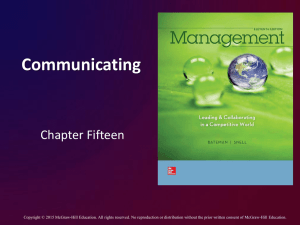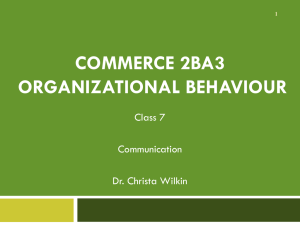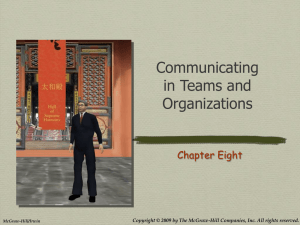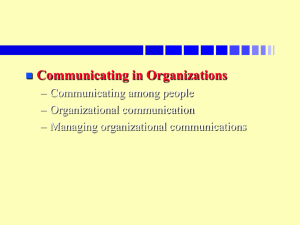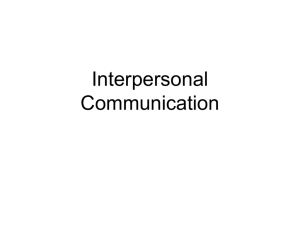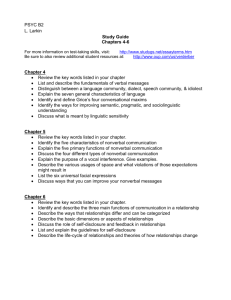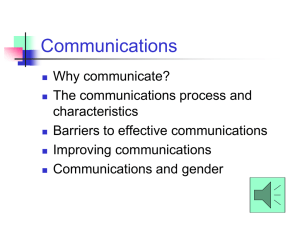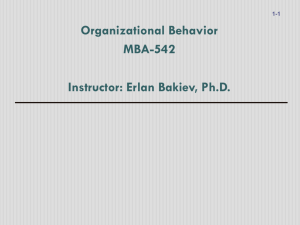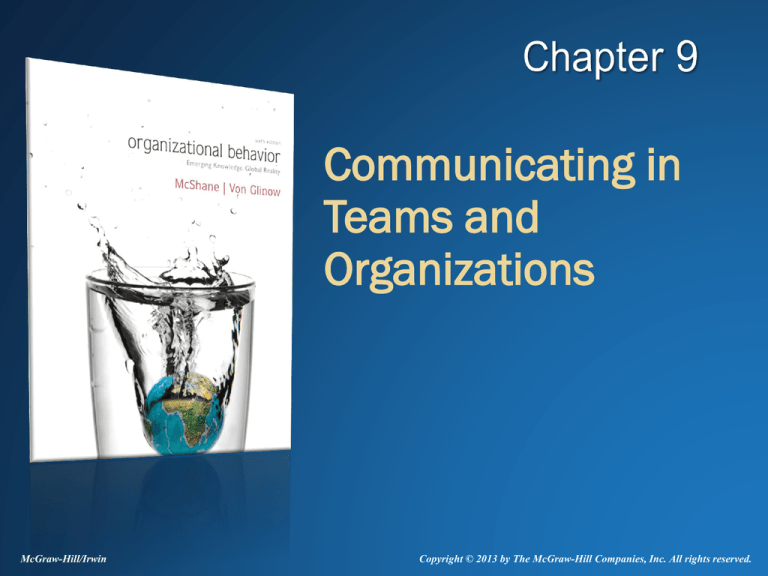
Communicating in
Teams and
Organizations
McGraw-Hill/Irwin
Copyright © 2013 by The McGraw-Hill Companies, Inc. All rights reserved.
Communication at Zappos
Zappos CEO Tony Hsieh values
open communication with staff,
such as sending Twitter tweets,
writing blogs, and having an office
with no door.
9-2
Communication Defined
The process by which
information is transmitted
and understood between two
or more people
Effective communication
• Transmitting intended meaning
(not just symbols)
9-3
Importance of Communication
1. Coordinating work activities
2. Vehicle for organizational learning
3. Critical ingredient for decision making
4. Influencing others – changing their
behavior
5. Employee well-being
9-4
Communication Process Model
Sender
Form
message
Transmit
Message
Encode
message
Receiver
Receive
encoded
message
Decode
message
Encode
feedback
Form
feedback
Noise
Decode
feedback
Receive
feedback
Transmit
Feedback
9-5
Improving Communication
Coding/Decoding
1.
Communication channel proficiency
Sender/receiver have motivation and ability to use the
communication channel
2.
Similar codebooks
Both parties generate similar meaning from symbols,
language, etc
3.
Shared context mental models
Parties have a common understanding of the
environment
4.
Experience encoding the message
Sender is experienced at communicating the message
topic
9-6
Atos Origin Replaces Email with
Social Media Communication
European information
technology company Atos
Origin plans to replace email
completely with other Internetbased communication tools
within the next couple of years.
9-7
How Email has Altered Communication
Now preferred medium for
coordinating work
Tends to increase
communication volume
Significantly alters
communication flow
Reduces some selective
attention biases
9-8
Problems with Email
Communicates emotions
poorly
Reduces politeness and
respect (flaming)
Inefficient for ambiguous,
complex, novel situations
Increases information
overload
9-9
Communicating Through Social Media
User-generated content
• Users, not professionals, create the content
• Usually interactive -- viewer can respond
• Includes social sites -- Facebook, blogs, wikis,
tweets
Serves diverse functions
• Presenting individual’s identity, enabling
conversations, sharing information, sensing others’
online presence, maintaining relationships,
revealing status, supporting interest communities
9-10
Nonverbal Communication
Influences meaning of verbal symbols
Less rule bound than verbal communication
Most is automatic and nonconscious
Courtesy of Microsoft.
9-11
Emotional Contagion
The automatic process of sharing another
person’s emotions by mimicking their facial
expressions and other nonverbal behavior
Serves three purposes:
1. Provides continuous feedback to speaker
2. Increases emotional understanding of the other
person’s experience
3. Communicates a collective sentiment -- sharing
the experience as part of drive to bond
9-12
Choosing Channels: Social
Acceptance
Do others support use of that communication
channel for that purpose?
Depends on:
1. Firm/team norms for using the channel
2.
Individual preferences for using the channel
3.
Symbolic meaning of the channel
9-13
I Love Rewards Gets
Media-Rich Quickly
Every day at 11:15 am,
employees at I Love Rewards
Inc. meet face-to-face for 10
minutes to communicate
priorities and coordinate their
efforts. These quick meetings
provide a personal connection
and highly interactive feedback.
9-14
Choosing Channels: Media
Richness
The channel’s data-carrying capacity needs to be
aligned with the communication activity
High richness when channel:
1. conveys multiple cues
2. allows timely feedback
3. allows customized message
4. permits complex symbols
Use rich communication media when the situation is
nonroutine and ambiguous
9-15
Hierarchy of Media Richness
Rich
Overloaded
Zone
Media
Richness
Oversimplified
Zone
Lean
Routine/clear
Situation
Nonroutine/
Ambiguous
9-16
Computer-Mediated Exceptions to
Media Richness
Media richness theory less applicable to
computer-mediated channels because:
1.Able
to multi-communicate through lean
channels
2.More varied proficiency levels
3.Lean channels have less social distraction than
do media rich channels
9-17
Persuasive Communication
Changing another person’s beliefs and
attitudes.
Spoken communication is more persuasive
because:
• accompanied by nonverbal communication
• has high quality immediate feedback
• has high social presence
9-18
Communication Barriers
Perceptions
Filtering
Language
• Jargon
• Ambiguity
Information Overload
9-19
Information Overload
Episodes of
information
overload
Information Load
Employee’s
information
processing
capacity
Time
9-20
Managing Information Overload
Solution 1: Increase info processing capacity
•
•
•
•
•
Learn to read faster
Scan through documents more efficiently
Remove distractions
Time management
Temporarily work longer hours
Solution 2: Reduce information load
• Buffering
• Omitting
• Summarizing
9-21
Cross-Cultural Communication
Verbal differences
• Language
• Voice intonation
• Silence/conversational overlaps
Nonverbal differences
• Some nonverbal gestures are universal, but others
vary across cultures
9-22
Gender Communication Differences
Men consider more power, status,
functionality
• Report talk
• Give advice quickly
• Dominate conversation
Women consider more interpersonal
relations
• Rapport talk
• Indirect advice/requests
• Sensitive to nonverbal cues
9-23
Getting Your Message Across
1.
Empathize
2.
Repeat the message
3.
Use timing effectively
4.
Focus on the problem,
not the person
Courtesy of Microsoft.
9-24
Active Listening Process & Strategies
Sensing
• Postpone evaluation
• Avoid interruptions
• Maintain interest
Active
Listening
Responding
Evaluating
• Show interest
• Clarify the message
• Empathize
• Organize information
9-25
Communicating in Hierarchies
Workspace design
• Open offices – consider noise, distractions
• Clustering people in teams
Web-based organizational communication
• Wikis -- collaborative document creation
• E-zines -- rapid distribution of company news
Direct communication with management
• Management by walking around (MBWA)
• Town hall meetings
9-26
Organizational Grapevine
Early research findings
• Transmits information rapidly in all directions
• Follows a cluster chain pattern
• More active in homogeneous groups
• Transmits some degree of truth
Changes due to internet
• Email, social networking, tweets are becoming the
main grapevine media
• Social networks are now global
9-27
Grapevine Benefits/Limitations
Benefits
• Fills in missing information from formal sources
• Strengthens corporate culture
• Relieves anxiety
• Associated with the drive to bond
Limitations
• Distortions might escalate anxiety
• Perceived lack of concern for employees when
company info is slower than grapevine
9-28
Communicating in
Teams and
Organizations

